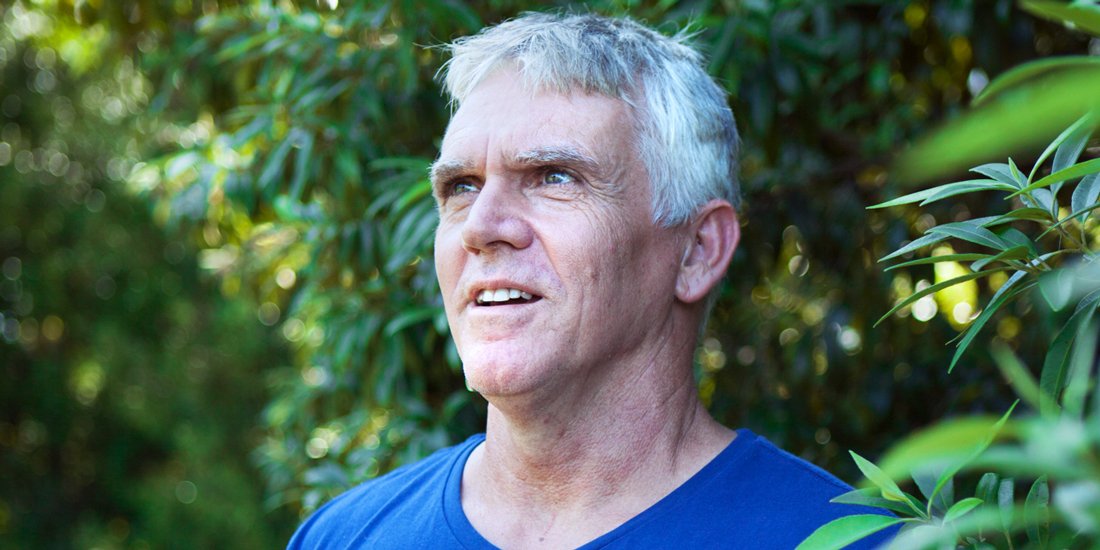Peter Hardwick, wild-food researcher, Harvest
There's no point in putting native ingredients into poor quality products, you want them to go into products and dishes where they really shine, so people can really understand it and get a sense of the potential ...
Have you ever met a wild-food researcher? How about a professional forager? No? Well, you’re about to. This is Peter Hardwick and he admittedly has one of the most unique occupations around. Born on the north coast of New South Wales, Peter is one of the most reputable minds in the world of foraging, native plants and horticulture. Armed with boundless experience and innate knowledge, Peter works closely with the talented team at Harvest Newrybar in a passionate effort to bring some of Australia’s most undervalued native ingredients to our plates. It’s certainly unique to see someone who has spent a lifetime researching and studying native plants come together with a distinguished hatted restaurant – but it’s a spectacular collision of two worlds and together they are creating some serious culinary magic. We caught up with Peter to chat about his obscure career path and his passion for the land.
What would you say is your earliest memory of foraging?
Probably when I was four years old in South West Rocks where my parents were living. Around the back of the house there was a dirt road and there was a bit of remanent heath land and patches still there, and we were harvesting the native honeysuckle (a plant I can actually put a botanical name to now!) and sucking the nectar from the flower. My brother reminded me of that memory – it was a long time ago, so it wasn’t just a fabrication … or a dream!
A ‘wild-food researcher’ is a rather obscure career path. At what point did you realise that this was what you wanted to do?
I decided it was going to be a career path when I was around 18. I was listening to a radio program about logging the sole growth-patch of rainforest that is now the Border Ranges National Park, which didn’t go ahead. At the time, they were going to chop down this very rare piece of forest and the forester came on the radio and said there was nothing of value in the forest other than timber … and I thought, that’s not true! Right through my life I was very interested, and when this happened I thought – that’s it, this needs to be corrected, I’m going to devote my attention to making everybody aware of the value of native foods. I am going to go out and research native foods for their commercial value, just to get across that these can be used as crops and can be farmed. No one had done this in a systematic way, so that’s when it started for me. I guess I was really driven by a passion for conservation initially.
You’re currently working with the talented team at Harvest Newrybar. When did you realise that your career could cross over into working with some of the country’s top kitchens and hatted restaurants?
Interestingly, it was a very early realisation. I remember going with my parents to an RSL club in Tweed Heads when I was in my late teens, and I remember eating an avocado, which was a real novelty in those days. I remember sitting back and watching them unpack the avocados thinking ‘hey, restaurants are going to be a really good vehicle for doing this work’. Then, I became really involved in the first wave of native restaurants that came through in the late 80s. Working with chefs is very, very important. It makes sense to make sure that native ingredients are supplied to chefs, because they are the ones who are going to really do good things with the ingredients, and introduce them to people in a nice way. There’s no point in putting native ingredients into poor quality products, you want them to go into products and dishes where they really shine, so people can really understand it, get a sense of the potential, and use it at home. It’s kind of like the avocado 40 years ago … people didn’t know what to do with them. My mum and dad tried to eat them when they were rock hard!
For the uninitiated, what are some of the key benefits of native foods?
There are environmental benefits, because these are native crops and they have adapted to the local environment, which means you can regenerate to some extent when you crop them at the same time. The health benefits are really outstanding. A lot of things get referred to as ‘super foods’ these days, but there are so many nutritional and nutraceutical values with native-food compounds that we’re only just finding out about. As we delve into the phytochemistry, which we do to make sure it’s safe to consume, you also find other properties such as anti-inflammatory properties or metabolic benefits. A lot of the beneficial compounds that we find in native foods can counter some of the negative effects of eating bad Western food over a period of time. More established native foods are better researched – some of the native foods we worked on in the 80s have had their properties better unpacked over the last 30 years, so the research into the nutritional benefits is really ongoing.
Do you think native ingredients have a more common place in today’s general food industry?
Definitely. You’re certainly starting to see native ingredients in mainstream markets, especially fruit ingredients like Davidson plum and quandong. Whilst there have been many reasonable attempts to put them into supermarkets, it’s still fairly low in volume … unless you’re talking about things like macadamias! It’s a slow train in terms of getting farmers on board and getting the right varieties. It takes time and it can’t happen overnight. We have a strong cultural and culinary knowledge base around food, but it just takes time for people to understand it all fully.
After doing this for such a long time, one would think that you’ve discovered all there is to discover! Are you still uncovering new native plants, fruits and ingredients?
Absolutely! You can spend many lifetimes studying the plants of one region, it’s extraordinary. I have been doing a lot of fermenting over the last ten years and it opened a door of potential. It’s all the rage now, but for good reason. When you open a door like that, you go ‘wow’, but it just keeps going. There’s no horizon – you see the potential with foods, you reach it, then you look ahead and there’s a new horizon of new ingredients. The humbling thing is that you realise the reach of the traditional knowledge, which has been around for thousands of years, and you realise the culinary knowledge that must have come with that – and this knowledge still survives, which is so wonderful to see. On one level, everything I ‘discover’ so to speak, somebody else knew about this however long ago. When I share the knowledge back with the indigenous community, they say “yeah, we know that plant”, which is a great thing. It’s a process of re-discovery.
Tell us, what are some of the most exciting ingredients you’ve been bringing into the Harvest kitchen lately?
There are lots. There’s pandanus vinegar, like a kombucha vinegar – I’ve got a wild kombucha culture that I captured off a pandanus on the tail end of 2015, and it’s got a lovely caramel note that acquires over time as it ages. We’ve been doing a charred kelp vinegar (has a stouty note) and a tea-tree vinegar (more of a pear flavour). We’ve also been working with bunya cones, which I’ve made a vinegar out of, as well as cumin eucalyptus, sea purse and local coastal salt bush, which is really lovely as a tempura.

